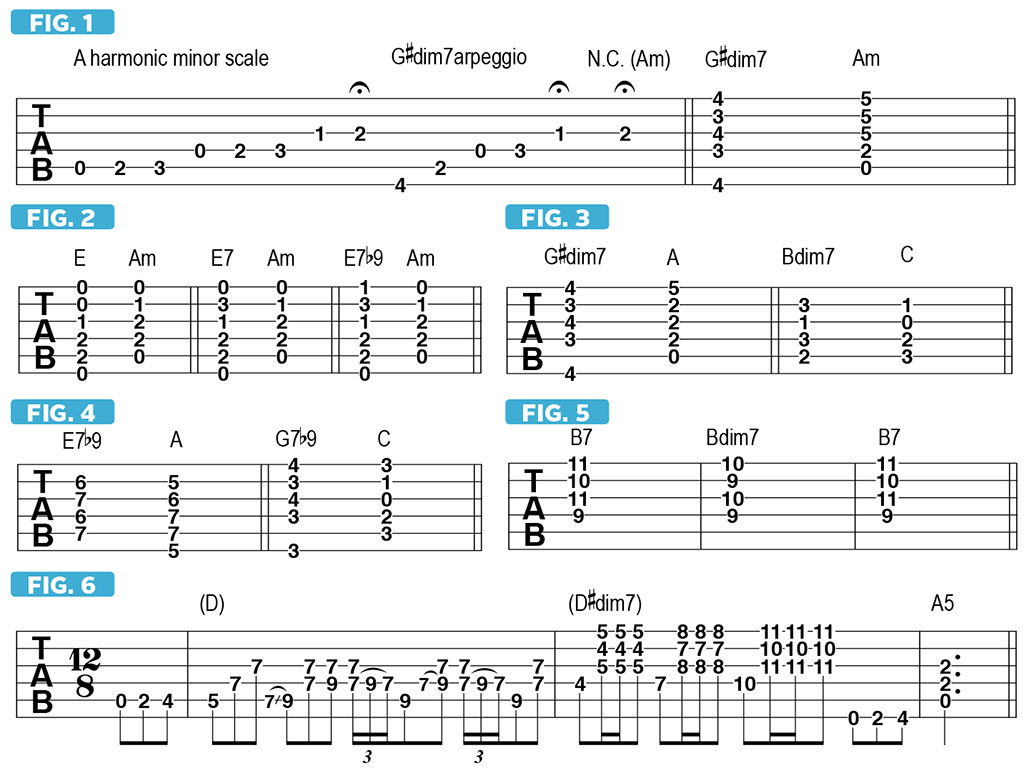The Ultimate Transition Chord, Part 2: Major and Bluesy dim7 Resolutions
Learn some interesting applications of this harmonic enigma, and a few ways to get more musical mileage out of it.
Continuing our protracted exploration of diminished seven (dim7), I’d like to demonstrate a few more interesting applications of this harmonic enigma and ways to get more musical mileage out of it. But first, a quick review.
Last time, I explained dim7’s theoretical basis: it’s the seventh seventh chord of the harmonic minor scale, which is intervallically spelled 1 2 b3 4 5 b6 7. [Remember, when identifying intervals, many musicians use the term “flat” (b) instead of “minor” (m).] So, for example, within A harmonic minor (A B C D E F G#) live the notes of G#dim 7 (G# B D F), all of which satisfyingly resolve to an Am triad (A C E; see FIGURE 1). So that’s the traditional use of dim7 — as a leading-tone resolution to a minor chord rooted a half step above it, the leading tone being the seventh scale degree. And, as you recall, the vii dim7 may be superimposed over the root of the V (five) chord, E in this case, to form a tart-sounding dominant seven flat-nine (V7b9), spelled 1 3 5 b7 b9, which offers a more intense resolution to the i (one minor), for example E7b9 to Am, than does the milder V7-to-i cadence E7 to Am, or the even tamer V-i, E to Am (see FIGURE 2).

By the mid-19th century, composers and songwriters alike started to freely “borrow” minor, or “flat,” intervals from a major key’s parallel minor key, which is based on the same root — for example, A major and A minor — to create bittersweet progressions and melodies, using darker-sounding notes from the minor key, such as the b6, to dramatically contrast with the brighter quality of the major tonality. Along with this trend came the now standard move of resolving a dim7 to a major chord, either as a leading-tone — vii dim7 to I (one major), for example, G#dim7 to A, or Bdim7 to C (FIGURE 3) — or employing it as a b9 in a dominant-tonic cadence, which makes for a very welcome release, as that tart, restless V7b9 chord resolves to the pleasing I (one) major, for example, E7b9 to A, or G7b9 to C (FIGURE 4).
Another intriguing use of dim7 that eventually made its way into the vocabulary of blues, jazz, pop, country and other “folk” music styles in what’s called the commontone diminished resolution, which entails moving from a straight major or dom7 chord to a dim or dim7 built on the same root note, then back, which creates a “sweet, melancholy, sweet” effect. A famous example of this move is the opening to “Red House” by Jimi Hendrix, where, with his instrument tuned down a half step, the inventive guitarist arpeggiates the chord change B7-Bdim7-B7 while gently shaking the notes with his fret hand to create a slide-like warble, using the voicings shown in FIGURE 5. The great Robert Johnson and other early Delta blues pioneers had previously employed a similar move in various keys and positions.
In blues and urban gospel music, songwriters will often insert a dim7 after the IV chord to create a “chromatic climb” — IV to #IV dim7 — before moving back to the I, which is sometimes in second inversion (with the fifth in the bass), to continue the climb. This produces a smooth yet dramatic buildup that has been appropriately described as the “gospel lift.” A good and fairly well-known example of this move can be found in blues legend Johnny Winter’s cover of the holiday song “Please Come Home for Christmas,” which he performed as if it were in the key of A, but it sounded in G, due to his guitar being tuned down a whole step. In the third bar of each verse, the progression goes from D to D#dim7 then back to A, with the D# note resolving in our mind’s ear to E, the fifth of A. This move first occurs at 0:17 into the track, and FIGURE 6 illustrates the basic voicings.
Another great but less well known example of the gospel lift can be found in the soulful, uplifting and harmonically sophisticated worship song “The Battle Is the Lord’s,” recorded and beautifully sung by Yolanda Adams. Specifically from 2:24-2:32 and 2:52-2:57, the progression, which is in the key of D, goes from G to G#dim7 to D/A, making great use of the second-inversion I (one) chord (D/A).
All the latest guitar news, interviews, lessons, reviews, deals and more, direct to your inbox!
Over the past 30 years, Jimmy Brown has built a reputation as one of the world's finest music educators, through his work as a transcriber and Senior Music Editor for Guitar World magazine and Lessons Editor for its sister publication, Guitar Player. In addition to these roles, Jimmy is also a busy working musician, performing regularly in the greater New York City area. Jimmy earned a Bachelor of Music degree in Jazz Studies and Performance and Music Management from William Paterson University in 1989. He is also an experienced private guitar teacher and an accomplished writer.

